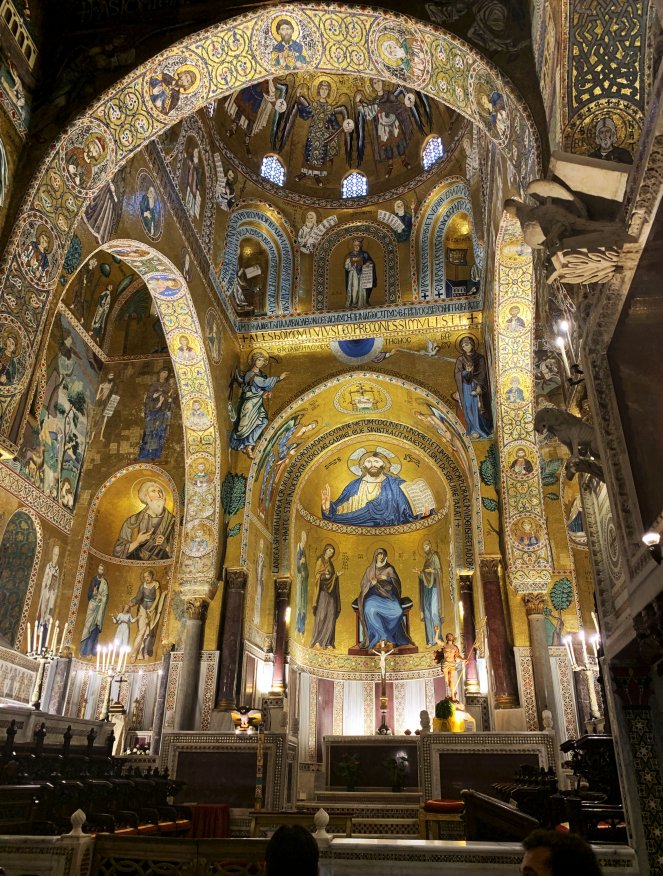Cappella Palatina
 In 1132 King Roger (d.1154) ordered a chapel dedicated to St Peter built in the centre of his Norman palace.
It is said to have been finished by 1140, but
the mosaics were still unfinished in 1143. Archbishop Romuald of
Salerno (1153-82), who would have visited the structure, stated:
In 1132 King Roger (d.1154) ordered a chapel dedicated to St Peter built in the centre of his Norman palace.
It is said to have been finished by 1140, but
the mosaics were still unfinished in 1143. Archbishop Romuald of
Salerno (1153-82), who would have visited the structure, stated:
King Roger... ordered a
beautiful palace to be built in Palermo in which was constructed a
chapel floored in astonishing stone which he had covered with a gilded
roof and endowed and beautified with various ornaments.
The original nave did
not contain any Christian images and these were later added by the 2 King Williams (1154-89).
One of the kings also installed the royal throne. This once
stood against the west wall of the
nave, but all that remains of this are the six steps up to it guarded
by the two Hauteville lions. King William I
(d.1166) was actually
buried in the chapel and during his reign he had the place 'painted
with marvellous pictures, covered its walls with different sorts of
valuable marble and greatly enrich and ornamented it with gold and
silver vessels and precious vestments...'. Around 1350 the west
mosaic portraying Christ between St Peter and St Paul was added.
Description
Architecturally the chapel epitomises the eclectic mix of the Norman
state. It was
built at first floor level making the older chapel, said to be Norman,
into its crypt. In
layout the Palatine chapel is Byzantine with 3 apses, a domed
roof and mosaics, but it has 6 Arabic pointed arches resting on
classical columns and has Arab and Latin inscriptions in a Norman
layout. There are also clusters of 8 pointed stars, typical of
Muslim design, but these are arranged on the ceiling to form a
Christian cross. The nave roof is in an Iraqi muqarnas style and
consists of varied carvings from daily life to plant and animal designs
as well as Latin, Greek and Arab inscriptions. This would appear
to be the roof that so amazed Archbishop Romuald. The church is
generally considered to have a Byzantine sanctuary and a Norman
basilica
style nave, the perfect mix of east and west. Within the chapel
is a tall paschal candelabra decorated in relief with both flowers and
figures. One of the scenes shows Christ with King Roger
kneeling before him. Again, like the Martorana, this emphases the
special relationship the kings of Sicily had with God, to the detriment
of the pope.
Perhaps the most famous feature of the chapel are its extensive
mosaics. These are generally Byzantine in style, although some are
Arabic in influence, like the depiction of King Roger
(d.1154) on the muqarnas ceiling. The earliest mosaics are
thought to be the Christ Pantocrator in the dome. The sanctuary and
transepts and are generally attributed to Byzantine craftsmen.
Those of the nave are thought to date more to the 1160s or 1170s
as they are cruder and feature Latin rather than Greek inscriptions.
Why not join me here and at other Sicilian
churches? Information on this and other tours can be found at
Scholarly
Sojourns.
Copyright©2019
Paul Martin Remfry
 In 1132 King Roger (d.1154) ordered a chapel dedicated to St Peter built in the centre of his Norman palace.
It is said to have been finished by 1140, but
the mosaics were still unfinished in 1143. Archbishop Romuald of
Salerno (1153-82), who would have visited the structure, stated:
In 1132 King Roger (d.1154) ordered a chapel dedicated to St Peter built in the centre of his Norman palace.
It is said to have been finished by 1140, but
the mosaics were still unfinished in 1143. Archbishop Romuald of
Salerno (1153-82), who would have visited the structure, stated: